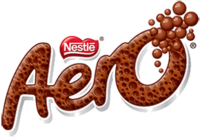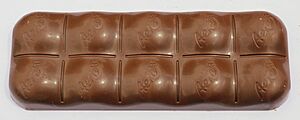Aero (chocolate bar) facts for kids
 |
|
 |
|
| Owner | Nestlé |
|---|---|
| Introduced | 1935 |
| Markets | U.K., Ireland, Canada, Australia, Germany, South Africa, Japan |
| Previous owners | Rowntree's |
Aero is a special chocolate bar made by Nestlé. It's known for its unique "bubbly" texture. This means it has lots of tiny air bubbles inside. When you eat it, the bubbles melt, giving it a cool feeling.
Aero bars were first made in 1935 by a company called Rowntree's in the United Kingdom. They were very popular right away. Soon, people all over the U.K. were buying them. By 1936, Aero chocolate was sold in New York City. It then spread to many other countries. These included Canada, South Africa, and Japan. Nestlé took over Rowntree's in 1988. Since then, Nestlé has made Aero bars. You can find Aero in many different flavours. There are also other Aero treats, like Aero Bubbles and Aero Biscuits.
The Story of Aero Chocolate
How Aero's Bubbles Are Made
The way Aero chocolate is made was invented in 1935. This happened at the Rowntree's factory in York, England. First, the chocolate is warmed up. Then, air is added to it. This creates tiny bubbles inside. The bubbly chocolate is then poured into molds. These molds already have a solid chocolate shell. As the chocolate cools, the air pressure inside changes. This makes the bubbles grow bigger inside the bar.
Aero's Early Days
Rowntree's launched Aero in the United Kingdom in 1935. The Peppermint Aero came out in 1959. The original wrapper was brown. The mint version had a green wrapper. Both showed the "Rowntree's" name and a big "AERO" logo. A fun slogan was "Hold on tight or I'll fly away!"
In 2014, old Aero packaging was put online. Historians at Rowntree's did this. It was to help people with dementia remember things. The old wrappers from the Nestlé UK & Ireland Archive were later made into a "reminiscence pack." This pack helped people recall memories. It even had a 1950s Aero label. This label could be put on modern products. A 1953 Aero wrapper celebrated the Queen's coronation.
Aero Around the World
The Aero bar was sold in the United States for a short time in the 1980s. It didn't become very popular then. However, you can still find them in some special stores. These stores import the bars from other countries. Another company, The Hershey Company, also sold Aero bars in the U.S. from 1937 to 1939. Hershey later made a similar bar called Hershey's Air Delight. But this bar is no longer sold.
In Brazil, the bar is called Suflair. But in 2014, Nestlé also launched Aero there. In Hungary, it's known as Boci Aero. In the Netherlands, it's called Bros, which means "brittle." Aero is very popular in South Africa. You can find Aero, Aero Mint, White Aero, and Cappuccino Aero there.
Making Aero in Different Places
Aero bars were made in Australia from the early 1970s until 1996. After that, they were made in Britain. In 2011, Nestlé started making Aero bars in Australia again. They built a factory in Victoria. This factory can make up to 1000 tons of chocolate each year. The Australian bars had a different recipe. They were smoother and creamier. The Aero bars sold in Britain kept the older recipe.
In 2001, Nestlé Canada said their Aero bars might contain nuts. This was because they were made in the same factory as nut-containing bars. People were very upset about this. So, in May 2001, Nestlé changed its mind. They promised that Canadian Aero bars would still be nut-free.
In 2004, Ukraine also started making Aero bars. In Germany, a different company, Trumpf, owns the Aero brand. Their Aero bars are different from Nestlé's. They are solid chocolate with carbon dioxide bubbles. They don't have a filling.
Aero's Influence Beyond Chocolate
Aero's bubbly texture has inspired people in other fields. In 1998, a rocket fan named Derek Willis was eating an Aero bar. He got an idea from the bubbles. This led him to create a low-cost rocket fuel. He called it Asprop, which means "Aerated Solid Propellant."
In 2011, a Ford engineer named Carsten Stake was also inspired by Aero. He wanted to make car parts lighter. He used the idea of bubbles to make plastic engine covers lighter. This new plastic has gas bubbles injected during molding. It creates a honeycomb-like structure. This makes the parts 20% lighter. Lighter parts help cars use less fuel.
Aero's Slogans and Ads
Old Slogans (1930s-1980s)
In the late 1930s, Aero ads used the slogan, "You get a lift." In Australia in 1938, ads called Aero the "...original English aerated milk chocolate... ...crisp, light and yet so sustaining."
Aero production stopped during World War II. It was relaunched in the 1950s. The new ads showed paintings of "ordinary" women. The slogan was "Different... For her, Aero - the milk chocolate that's different!" These paintings were called "Aero girls." Some of them decorated the York factory for many years.
In the 1970s, Rowntree's had an ad where children flew an Aero bar like a kite. In the 1980s, the slogan in Australia was "It's the bubbles of nothing that make it really something." Later, the slogan became "Have you felt the bubbles melt?" This slogan was created by Nick Welch. He is the father of Florence Welch from the band Florence and the Machine.
Modern Ads (1990s-2010s)
In 1993, Aero packaging in America said, "Melt into the moment." TV ads showed a woman taking a bath in liquid chocolate. In 1996, Nestlé changed Aero's packaging. New TV ads used the phrase "Great chocolate taste." The chocolate blocks were also changed to be easier to break.
In 2001, Nestlé UK launched the "All Bubble. No Squeak." campaign. It featured a computer-generated mouse character named Aeron. The ad showed a man buying an Aero bar. It came with a free hula-hooping mouse. He didn't want the mouse because the chocolate bar was good enough on its own. This animated mouse even won an award!
In 2002, Nestlé Canada found that people liked to break Aero bars. Then they would let the pieces melt in their mouths. Their ads showed two women. One bit into the bar, and the other said, "What are you doing? That's not right." This showed the best way to enjoy Aero.
In 2009, a famous skateboarder named Bob Burnquist was in a UK ad. He skated through chocolate-colored balloons. The song "ABC" by the Jackson 5 played in the background. The slogan in 2011 was "Irresistabubble." This was an old slogan from the 1980s. It was created by the famous writer Salman Rushdie when he worked in advertising.
Aero Flavours and Products
Aero comes in many flavours. The original is just milk chocolate. But the bubbly texture has also been used in other sweets and desserts.
Regular Aero Bars
- Milk Chocolate (the original)
- Mint Chocolate (green, bubbly mint inside, covered in milk chocolate)
- Orange Chocolate
- Dark Chocolate (70% cocoa)
- 2 in 1 (Milk Chocolate shell with White Chocolate filling)
- Strawberry (released in the 1970s)
- Lime (for a short time in 1971)
- Cappuccino (a limited edition in 1996)
- Latte
- Snow (white chocolate, relaunched in 2000)
- Milk Chocolate with Cranberry Flavor (limited edition in 2000 and 2001)
- Honeycomb (milk chocolate with honeycomb pieces)
- Caramel (released in 2004, some have a gooey caramel)
- Crispy (like Nestlé Crunch bars)
- Vanilla Milkshake, Hot Milk, Green Tea, and Aero Cocoa (made in Japan)
- Irish Cream (available in Ireland around 2004-2005)
- Sticky Toffee (released in 2005)
- Vanilla Yogurt (introduced in Canada in 2006)
- Chocolate Truffle (a fancy version from 2006)
Chunky Aero Bars
- Milk Chocolate (the Chunky version came out in Canada in 2001)
- Mint Chocolate (a "Limited Edition" from 2000 to 2010)
- White Chocolate (a limited edition for Christmas in 1998 and 2002)
Aero Bubbles
Aero Bubbles are small, round pieces of bubbly chocolate. They come in a bag that you can close again. In 2012, Nestlé stopped using artificial colours in their sweets. So, the green colour in Mint Aero Bubbles now comes from a plant extract.
- Milk Chocolate
- Mint Chocolate
- Orange Chocolate
- Strawberry Milk Chocolate
- White Bubbles (milk chocolate outside, white chocolate bubbles inside)
- Caramel Bubble Bar (caramel-flavoured white chocolate inside, milk chocolate outside)
Aero Biscuits
On May 4, 2011, Nestlé launched the Aero Biscuit. It has classic Aero chocolate and round biscuit pieces. You can buy it in the United Kingdom and Ireland.
- Milk Chocolate
- Mint Chocolate
- Orange Chocolate
- Pink Lemonade
Aero Mousse (Dessert)
Aero Mousse is a chilled dessert. It comes in milk chocolate and peppermint flavours. It was the first product made by both Nestlé and Rowntree after Nestlé bought Rowntree in 1998. Aero Mousse was introduced in Australia in 2001. In 2008, the UK mousse range added Mint and Choc flavours. They were also renamed Aero Bubbly Dessert.
Aero Mousse (Bar)
The Aero mousse chocolate bar came out in May 2015. It has a mix of Aero chocolate and chocolate mousse inside a chocolate shell. It's sold as single bars and larger sharing bars.
Aero Drinks
Aero chocolate drinks were released in 1991. They came in chocolate and chocolate mint flavours. The packaging told people to "Chill 'n' shake" to make bubbles in the drink. An orange chocolate flavour was added in 1992.
Aero Instant Bubbly hot chocolate packets were released in 2006. These packets make frothy, bubbly hot drinks. They come in Chocolate and Mint Chocolate flavours.
Aero Ice Cream
Aero Ice Cream bars were released in the United Kingdom in 1995. These bars had Aero chocolate inside a chocolate shell. They were surrounded by Aero chocolate ice cream. In 2010, new Aero ice creams were made. These included Aero Double Bubble, which was mint and chocolate ice cream with bubbly chocolate pieces. There was also Aero Bubbleball, a frozen chocolate and mint mousse with an Aero chocolate ball.
Aero Bliss
In April 2019, fancy Aero chocolates were released. They came in boxes with individually wrapped pieces. The boxes had Milk Chocolate, Salted Caramel, and a Mixed Selection (milk chocolate, salted caramel, and praline). These chocolates had a bubbly centre with crunchy pieces, all in a chocolate shell.
Seasonal Aero Treats
- Aero Mint Egg was released in January 1996 for Easter. It had light green mint-flavoured bubbles inside milk chocolate. A giant Aero Mint Egg was also available. In 2010, Nestlé Canada made Aero in the shape of an egg for Easter. The Aero Luvabubble Lamb was also released for Easter.
- Aero Christmas Pie was part of Nestlé's Christmas range in 1996. It combined Aero chocolate with spicy orange filling in a pie shape. For 2011, they made a chocolate Aero Christmas Tree. It was filled with bubbly peppermint.
- Aero Milk Chocolates Heart Box was promoted for Valentine's Day in Canada in 2003. It was a red heart-shaped box of Aero chocolates.
See also
- Mirage (chocolate)
- Wispa
- List of chocolate bar brands



